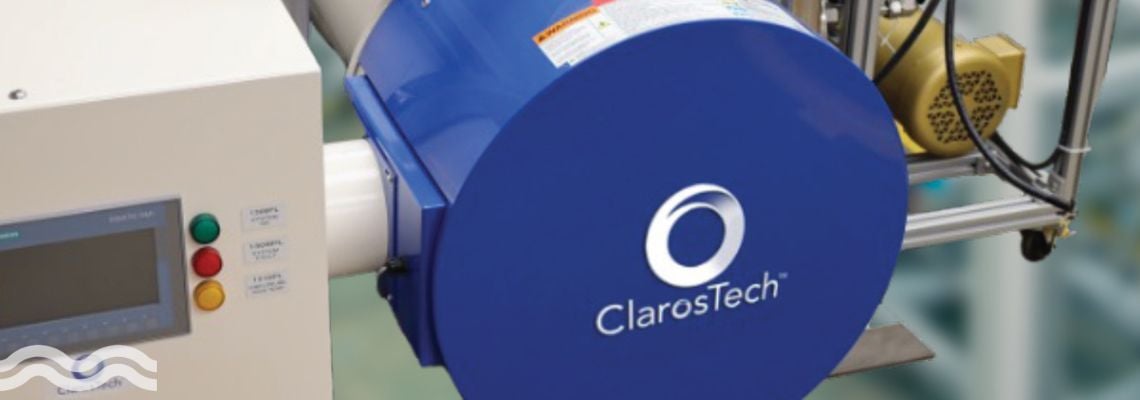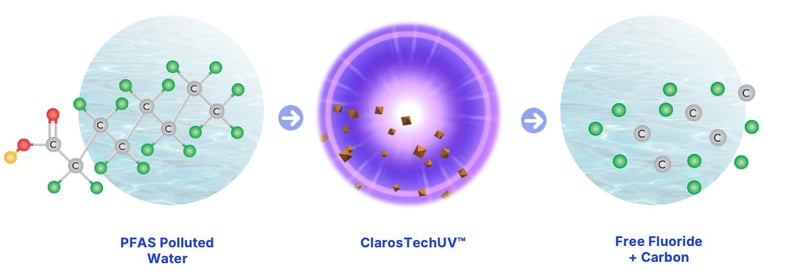A proprietary UV-photochemical process developed by US-based Claros Technologies has successfully achieved a 99.99 per cent destruction rate of targeted per- and polyfluoroalkyl substances (PFAS) in industrial wastewater streams using a proprietary UV system at a pilot site in Alabama.

The pilot took place at Daikin America Inc.'s (DAI) facility in Decatur, Alabama. Claros UV solution treated more than 50,000 gallons of wastewater in a high-flow system capable of achieving hundreds of gallons per minute.
Before the pilot, the Daikin facility was already achieving a 99.9 per cent reduction in large-chain PFAS in its wastewater treatment facility. The trial demonstrated that large-scale destruction of long, short, and ultra-short chain PFAS using UV technology is not only technically feasible but also economically viable.
Claros supports these destruction claims with customised analytical testing via LC-MS, HRMS, Method 1633, and non-target techniques, such as total organofluorine (TOF). The company states that the results have also been validated by third parties.

ClarosTechUV (Claros Technologies PFAS Destruction System) destroys long, short, and ultra-short chain PFAS species, with short-chain destruction being a key differentiator.
Doug Parker, PhD, vice president of Claros Technologies, told Aquatech Online that the system destroys all regulated PFAS compounds and many that are likely to be regulated in the near future. “We have successfully treated wastewater containing PFAS concentrations from hundreds of µg/L to single-digit mg/L, including long, short, and ultra-short chain carboxylic and sulfonic acid species.”
UV systems have a long history of being used in water treatment facilities. UV systems generally offer highly scalable, safe and cost-effective solutions for treating millions of gallons of water every day. ClarosTechUV uses advanced high-intensity UV systems designed specifically for PFAS destruction.
Parker explains Claris’ point of difference: “However, we have developed a proprietary photochemical process along with an optimised UV reactor designed to break PFAS apart at the molecular level.”
ClarosTechUV operates as a high-throughput reactor. Wastewater is directed through a treatment chamber where it is exposed to high-intensity UV under controlled operating parameters. Flow rates are adjusted based on influent characteristics, PFAS concentrations, and treatment objectives.
Parker explains the destruction process: “It is the combination of our proprietary chemistry and optimised reactor design that allows us to build systems that will defluorinate and destroy PFAS at typical industry process flow rates of hundreds of gallons per minute.”
Build systems that will defluorinate and destroy PFAS at typical industry process flow rates of hundreds of gallons per minute - Parker
He added: “UV itself does not destroy the PFAS compounds. It is in combination of our UV reactor and our proprietary chemistry and process. The process uses UV energy to initiate chemical reactions that break down PFAS molecules into smaller, non-toxic fragments. These reactions are tailored for the types of PFAS species present, with reactor configurations and operational settings optimised during pilot testing, allowing us to destroy 99.9 per cent of the target PFAS species at high throughputs.”
The system requires standard treatments to remove suspended solids and organics, as well as pH adjustment.
Parker explained another feature of the system: “An advantage of ClarosTechUV is its flexibility to be placed in various locations within the treatment train. Because we can operate at high throughputs, we can match the scale of industrial waste streams and be positioned directly in line with typical adsorption media, either in front or behind, to significantly extend bed life, allow for smaller adsorption units, reduce costs, and reclaim valuable floor space.”
Because we can operate at high throughputs, we can match the scale of industrial waste streams - Parker
He added: “This also decreases the media that must be reprocessed or disposed of, reducing additional PFAS-contaminated waste streams.”
There is no need for ultrafiltration or reverse osmosis to be used ahead of the ClarosTechUV system because it is capable of handling high volumes of PFAS concentrations ranging from thousands of parts per billion (ppb) to 100 ppb, helping to simplify the process and lower the cost.
If 99.99 per cent of PFAS are destroyed during the process, then what is left over?
Parker explained: “The destruction process byproducts are CO2 and free fluoride. ClarosTechUV utilises non-target analytical techniques like total organofluorine and high-resolution mass spectrometry, among others, to demonstrate complete breakdown of PFAS compounds without the generation of any fluorinated byproducts.”
ClarosTechUV is modular by design, which allows it to be easily integrated into existing treatment trains or scaled for new installations. It can be adjusted to meet the needs of both small and large systems based on waste stream volume and effluent goals.
With the pilot proving the efficacy of the system, Daikin America and Claros Technologies are moving forward with plans for additional pilot work and collaboration, focusing on further enhancing the flow and destruction capabilities of the technology.
In addition, Claros Technologies has secured €8.5m in convertible note financing to help accelerate commercial deployment of the system and to meet growing demand for low-cost, high-flow, field-ready PFAS destruction solutions. The financing is supported by a mix of existing backers and new investors.